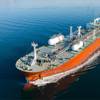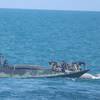A convincing economic argument fuels the liner shipping sector's adoption of unprecedented capacity ratings, with a new level soon to be reached in impending projects for newbuilds in the 9,000-TEU category, and technical work set in train for ships in the 10,000-12,500 TEU category. Experts believe that behemoths of 18,000-TEU could be in service on specific volume trades within a decade, yielding unit operating cost savings in the order of 30-percent relative to the 5,000-TEU size.
The enormous infrastructural implications attached to nurturing a new generation of ultra-large container vessels seem to be less daunting now compared with even a year ago, as the port and allied industries have demonstrated a readiness to invest in the requisite means for ensuring the expeditious working of such ships. A prudent design approach to marrying unprecedented stowage capacity within foreseen navigational constraints on the hull envelope, and access to technology tools which provide the means of rapid and reliable structural analysis, have brought the era of the mega-containership closer.
The latest catalogs of the two-stroke diesel engine market leaders MAN B&W and Wärtsilä defer to clients' requirements for advances in unit power concentrations, by including new, in-line models of cathedral engines with up to 14-cylinders, giving outputs of nearly 109,000-bhp (80,000-kW). Furthermore, MAN B&W has confirmed its willingness to provide single-engine, two-stroke solutions to power needs as great as 140,000-bhp, through models embodying up to 18 cylinders.
However, while the single-screw, single diesel engine approach is overwhelmingly preferred for deepsea containership propulsion, the limit to which it will actually be taken by the liner service providers and fleet operators will be governed by pragmatic considerations rather than solely by what is available and attainable technologically.
The standard single-engine, direct-drive arrangement can certainly be expected to be used for the next stage of development in containership size, but industry sources believe that any eventual move to considerably larger capacities still will foster twin-engine, twin-propeller configurations. The area encompassed by what is currently on the drawing board and the purely conceptual designs of colossal capacity could also provide opportunities for hybrid propulsion concepts, combining proven systems.
ABB Industry's Rami Jokela has provided new food for thought in this respect by advocating the use of the proprietary Azipod podded propulsion system in conjunction with a conventional, low-speed diesel-driven propeller as an effective solution for the upcoming generation of ultra-large boxships. An essential element of the proposal is that the diesel-electric pod propeller would contra-rotate behind the main propeller.
It is claimed that this would give the increased propulsion efficiency associated with a contra-rotating arrangement, but without the complexities of established contra-rotating propeller solutions based on concentric shafts. The concept put forward by Jokela is targeted at vessels over 9,000-TEU, and its economic merits are most pronounced in relation to twin-screw solutions. It has been formulated in mind not only of the raw propulsive power needs of the huge new ships, but also of the rising onboard requirement for electrical energy attributable to growing provision for refrigerated containers. Reefer box slots can typically account for up to 10-percent of total stowage in the large new classes of post-Panamax linehaul vessel, requiring a very substantial auxiliary genset outfit.
It is claimed that a combination of low-speed diesel plus a genset plant that can feed electrical power to the pod end of the propulsion system plus all other shipboard consumers offers savings of some 17-percent in total installed power in relation to an outfit based on twin main engines and auxiliary gensets. The azimuthing podded propeller offers a degree of redundancy, and would contribute to better maneuverability, as well as enabling rudder systems to be dispensed with.
Although the Finnish company contends that cavitation would be within acceptable limits, some experts believe that more hydrodynamic work needs to be undertaken to ensure satisfactory blade cavitation performance with systems where the podded propulsor is to be used for steering purposes.
Ideas Management
In a bid to create an effective structure for stimulating and assessing ideas suggested to or generated within the organization, Germanischer Lloyd has implemented a system known as innovation management.
The main objective of the initiative is to provide strategic guidance for all future technical developments undertaken by the society, so that time, people and resources are utilized in a more focused manner. The move is also designed to create more of an incentive to personnel to be forthcoming with ideas, and to provide a fast-track route to the development of agreed projects in targeted areas. A dedicated innovation manager drawn from GL's technical research domain, Pierre Sames, has been appointed to head up the operation.
The systematic collection and promotion of ideas will feed into the society's research and development (R&D) endeavors. GL has always taken a pragmatic line towards R&D, in looking towards projects that can deliver tangible benefits in terms of services, technology and products. One of the tasks of the innovation manager will be to better ensure that ideas are relevant to the society's more focused approach in expanding or establishing competence in selected areas.
Although the innovation management process was only set in train towards the end of last year, the society collected about 90 ideas in the 12 months to April this year, about 20 percent of which emanated from its field services. A total of eight proposals or concepts were subsequently investigated, resulting in the uptake of two as development projects since last October.
It is estimated that around a third of the ideas were rejected outright for being outside the bounds of GL's actual or intended areas of activity.
The ideas management framework accordingly addressed the perceived requirement for a systematic, internal approach to the collection of ideas for services and products, and to the task of identifying those, which ally with the society's strategic development objectives. The system that has been laid down opens up possibilities whereby the proposer of the idea might come to take an active role in the development process, if the project is authorized.
The very fact that a process has been implemented to give individuals a voice and a hearing over such matters is regarded as positive from a staff motivation standpoint. It opens up the catchment for feedback, potentially stimulates more ideas, and helps provide a basis for a more creative organization, believes GL management. "With the new system, I have the possibility to catch ideas that might otherwise be lost," confirmed Mr. Sames. GL annually spends an estimated $8.4 - $12.6 million on R&D, with the larger projects sponsored either by the European Commission or the Federal Ministry of Education and Research (BMBF).
LR Report: 75 New LNG Ships Needed For The U.S.
Lloyd's Register (LR) said that between 27 and 75 new LNG ships will be needed to meet the demand for LNG over the next decade in the U.S. market alone. Results of an extensive study into the matter were released at released the LNG conference, “The role of LNG in North American and Caribbean gas supply in Washington D.C.”
Many factors have been considered by LR in its forecast of the LNG market, including consideration of replacement of aging existing ships, take-up of excess capacity at existing import terminals and a rash of new import terminal projects that are likely to succeed.
The U.S. market finds itself short of energy. Gas is the clean burning fuel-of-choice for the electricity-generating plants mooted for construction in the U.S. over the next decade. LNG is being targeted to provide a large proportion of this demand. This dictates new import, gasification and distribution facilities within the U.S. To serve these facilities, ships to transport the LNG are a pre-requisite since the most suitable exploitable sources are remote from the U.S. mainland.
Featured videos

Unlock Onboard Data Efficiencies

Inmarsat Enhances Service to Drive Digitalization

Tracking Foreign Vessels Working in the U.S. Jones Act Market
Subscribe for
Maritime Reporter E-News
Maritime Reporter E-News is the maritime industry's largest circulation and most authoritative ENews Service, delivered to your Email five times per week









